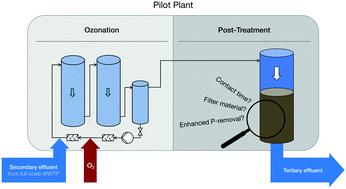当前位置:
X-MOL 学术
›
Environ. Sci.: Water Res. Technol.
›
论文详情
Our official English website, www.x-mol.net, welcomes your feedback! (Note: you will need to create a separate account there.)
Deep-bed filters as post-treatment for ozonation in tertiary municipal wastewater treatment: impact of design and operation on treatment goals
Environmental Science: Water Research & Technology ( IF 5 ) Pub Date : 2020-11-25 , DOI: 10.1039/d0ew00684j Daniel Sauter 1, 2, 3 , Agata Dąbrowska 4, 5, 6, 7 , Robert Bloch 1, 2, 3 , Michael Stapf 3, 8, 9 , Ulf Miehe 3, 8, 9 , Alexander Sperlich 1, 2, 3 , Regina Gnirss 1, 2, 3 , Thomas Wintgens 3, 10, 11, 12, 13
Environmental Science: Water Research & Technology ( IF 5 ) Pub Date : 2020-11-25 , DOI: 10.1039/d0ew00684j Daniel Sauter 1, 2, 3 , Agata Dąbrowska 4, 5, 6, 7 , Robert Bloch 1, 2, 3 , Michael Stapf 3, 8, 9 , Ulf Miehe 3, 8, 9 , Alexander Sperlich 1, 2, 3 , Regina Gnirss 1, 2, 3 , Thomas Wintgens 3, 10, 11, 12, 13
Affiliation

|
Ozonation followed by biological post-treatment is an established technology for abatement of organic micropollutants (OMP) from municipal wastewater. Although the necessity of biological post-treatment for oxidation by-product (OBP) removal is widely accepted, there is still discussion about the appropriate design and operation. The presented pilot-study investigates the impact of filter material and contact time on the removal efficiency of bulk organics, OMP, and OBP in three different deep-bed filters operated in parallel as post-treatment after ozonation (biological activated carbon (BAC) filter, dual-media filter sand/BAC and dual-media filter sand/anthracite). The use of BAC instead of non-adsorptive filter material resulted in higher removal of DOC and dissolved oxygen which indicates increased biological activity. Moreover, both BAC containing filters showed additional removal for a number of OMP even at high treated bed volumes of >50 000 whereas no removal was observed in the sand/anthracite filter. Analysis of N-nitrosodimethylamine (NDMA) and several carbonyl compounds revealed a clear formation of these biodegradable OBP during ozonation. A strong correlation was found between carbonyl formation and the specific ozone dose. Removal of OBP in the sand/BAC and the sand/anthracite filter was tested at different empty bed contact times (EBCT). While NDMA was efficiently removed independent of EBCT changes, there was a slightly negative impact of shorter EBCT on the reduction of carbonyl compounds. Furthermore, it was demonstrated that the integration of enhanced phosphorus removal into post-treatment is feasible with relatively low efforts by inline coagulant dosing (FeCl3) in the filter influent.
中文翻译:

深床过滤器作为三级市政废水处理中臭氧处理的后处理:设计和运行对处理目标的影响
臭氧化后再进行生物后处理是减少市政废水中有机微污染物(OMP)的一项成熟技术。尽管生物后处理去除氧化副产物(OBP)的必要性已被广泛接受,但仍在讨论适当的设计和操作。所提供的中试研究调查了在臭氧化后进行后处理的三种不同深床过滤器(生物活性炭(BAC)过滤器)中,过滤器材料和接触时间对大块有机物,OMP和OBP去除效率的影响。 ,双介质滤砂/ BAC和双介质滤砂/无烟煤)。使用BAC代替非吸附性过滤材料可提高DOC和溶解氧的去除率,这表明生物活性增强。此外,两种含BAC的过滤器均显示出对许多OMP的额外去除,即使在处理床体积大于50,000的情况下也是如此,而在砂/无烟煤过滤器中未观察到去除。分析N-亚硝基二甲胺(NDMA)和几种羰基化合物显示在臭氧化过程中这些可生物降解的OBP明显形成。发现羰基形成与特定臭氧剂量之间存在很强的相关性。在不同的空床接触时间(EBCT)下测试了砂/ BAC和砂/无烟煤滤池中OBP的去除。尽管可以有效地去除NDMA,而与EBCT的变化无关,但是较短的EBCT对羰基化合物的还原有轻微的负面影响。此外,已证明通过在过滤器进水中使用在线凝结剂定量给料(FeCl 3),可以以相对较低的努力将增强的除磷功能集成到后处理中。
更新日期:2020-11-25
中文翻译:

深床过滤器作为三级市政废水处理中臭氧处理的后处理:设计和运行对处理目标的影响
臭氧化后再进行生物后处理是减少市政废水中有机微污染物(OMP)的一项成熟技术。尽管生物后处理去除氧化副产物(OBP)的必要性已被广泛接受,但仍在讨论适当的设计和操作。所提供的中试研究调查了在臭氧化后进行后处理的三种不同深床过滤器(生物活性炭(BAC)过滤器)中,过滤器材料和接触时间对大块有机物,OMP和OBP去除效率的影响。 ,双介质滤砂/ BAC和双介质滤砂/无烟煤)。使用BAC代替非吸附性过滤材料可提高DOC和溶解氧的去除率,这表明生物活性增强。此外,两种含BAC的过滤器均显示出对许多OMP的额外去除,即使在处理床体积大于50,000的情况下也是如此,而在砂/无烟煤过滤器中未观察到去除。分析N-亚硝基二甲胺(NDMA)和几种羰基化合物显示在臭氧化过程中这些可生物降解的OBP明显形成。发现羰基形成与特定臭氧剂量之间存在很强的相关性。在不同的空床接触时间(EBCT)下测试了砂/ BAC和砂/无烟煤滤池中OBP的去除。尽管可以有效地去除NDMA,而与EBCT的变化无关,但是较短的EBCT对羰基化合物的还原有轻微的负面影响。此外,已证明通过在过滤器进水中使用在线凝结剂定量给料(FeCl 3),可以以相对较低的努力将增强的除磷功能集成到后处理中。



























 京公网安备 11010802027423号
京公网安备 11010802027423号